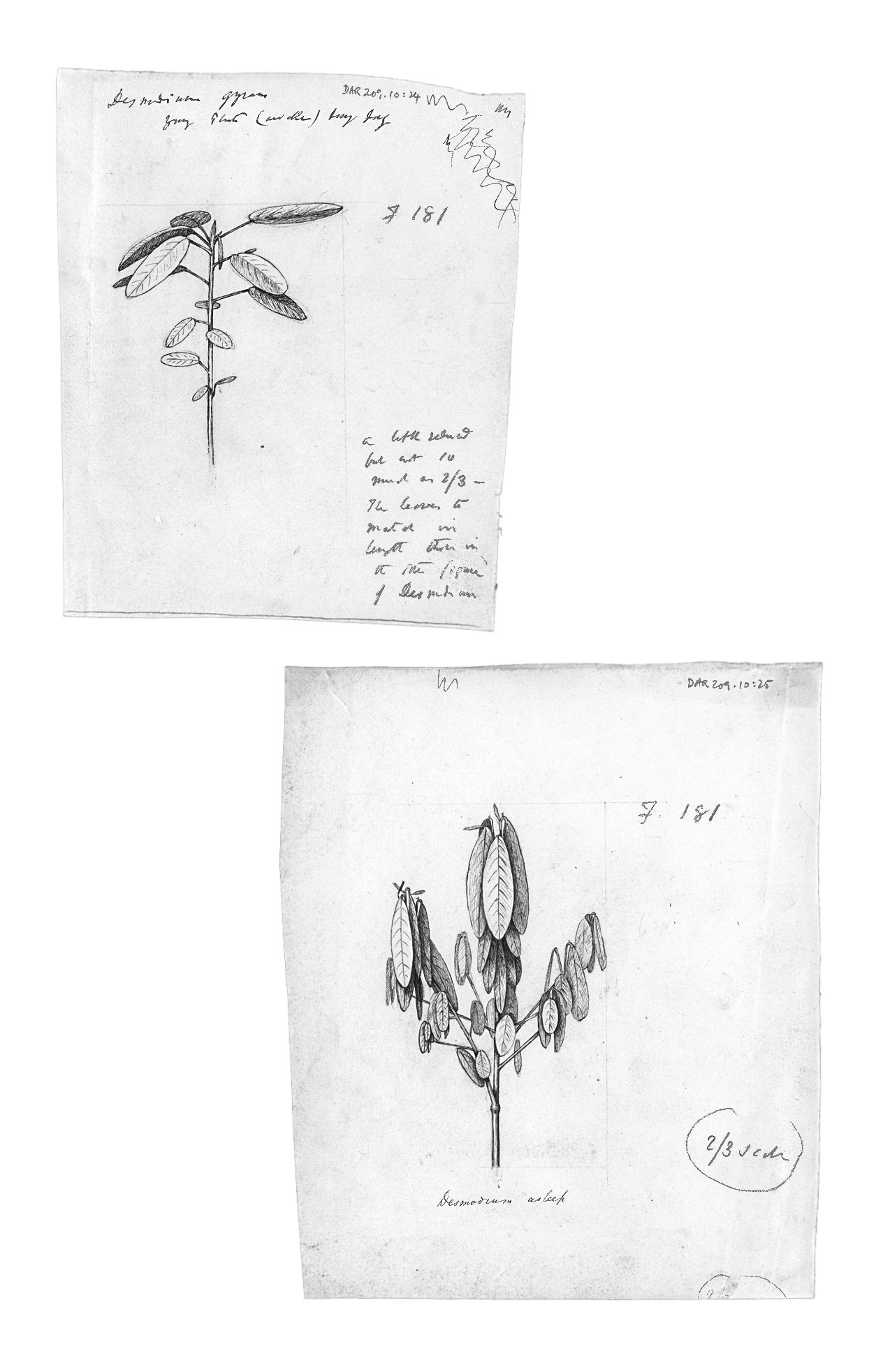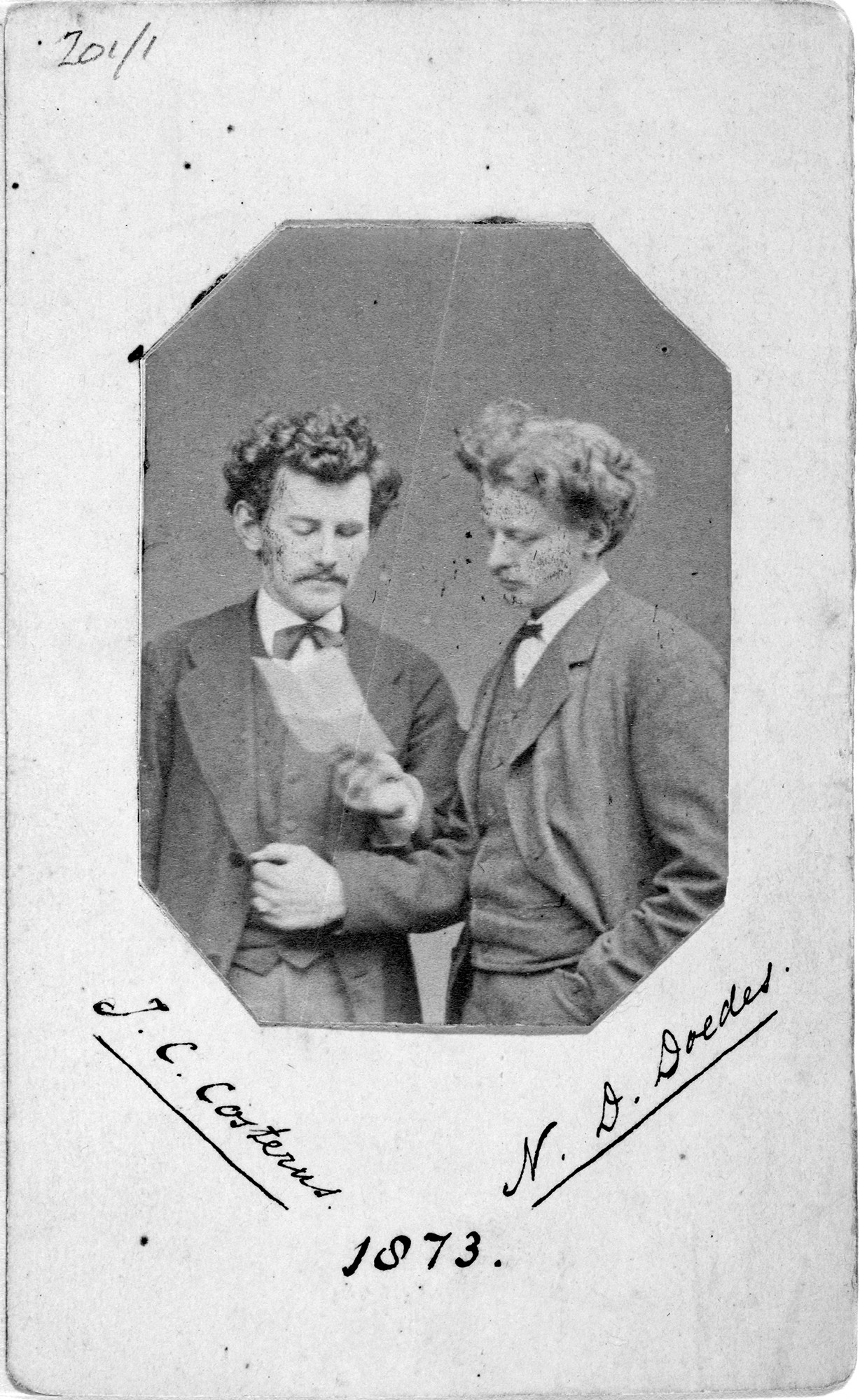To J. D. Hooker [18 May 1862]
Summary
Leschenaultia seems very odd. Will try with pollen left on for 48 hours. Illustrates diversity of structures for same purpose.
Bentham’s and Oliver’s good opinion of Orchids is reassuring.
Anxious to experiment on Melastomataceae; thinks it will give important results.
Wants Leschenaultia formosa to try whether viscid outside surface can be fertilised.
| Author: | Charles Robert Darwin |
| Addressee: | Joseph Dalton Hooker |
| Date: | [18 May 1862] |
| Classmark: | DAR 115: 154 |
| Letter no: | DCP-LETT-3558 |
Matches: 4 hits
- … DAR 115: 154 Charles Robert Darwin Leith Hill Place [18 May 1862] Joseph Dalton Hooker …
- … and by reference to the Darwins’ stay at Leith Hill Place, home of Caroline Sarah Wedgwood …
- … Wedgwood III . The Darwins stayed at Leith Hill Place from 15 to 22 May 1862 (see ‘ …
- … Leith Hill Place Sunday My dear old friend. I cordially thank you for your two letters; & …
To J. D. Hooker [9 May 1863]
Summary
Lists the six honest believers in his species theory in England.
Asa Gray complains that Lyell acts like a judge on species, whereas CD complains of Lyell’s indecision.
CD working on divergence of leaves.
Distribution of Cameroon plants and the glacial theory.
Survival of island relics.
| Author: | Charles Robert Darwin |
| Addressee: | Joseph Dalton Hooker |
| Date: | [9 May 1863] |
| Classmark: | DAR 115: 192 |
| Letter no: | DCP-LETT-4148 |
Matches: 4 hits
- … DAR 115: 192 Charles Robert Darwin Leith Hill Place [9 May 1863] Joseph Dalton Hooker …
- … Leith Hill Place Saturday My dear Hooker. You give good advice about not writing in …
- … s diary (DAR 242), the Darwins stayed at Leith Hill Place, near Dorking, Surrey, home of …
- … in Sussex from 27 April to 6 May, and at Leith Hill Place, near Dorking, Surrey, from 6 to …
To J. D. Hooker 14 October [1870]
Summary
Does not think so poorly of Nature as JDH does, by any means; fears Popular Science Review is rather ephemeral but more durable than Nature.
The case of the charlock.
| Author: | Charles Robert Darwin |
| Addressee: | Joseph Dalton Hooker |
| Date: | 14 Oct [1870] |
| Classmark: | DAR 94: 184–5 |
| Letter no: | DCP-LETT-7344 |
To J. D. Hooker 15 [May 1862]
Summary
Yellow anthers of Heterocentron produce on the same plant thrice as many seeds as the crimson anthers. Crimson anther seeds produce dwarf plants, others rise high up. Monochaetum ensiferum facts are still more strange. Wants to investigate the case, and asks for a plant of the Melastomataceae just before flowering.
Has JDH a Rhododendron boothii from Bhutan with pistil bent the wrong way?
| Author: | Charles Robert Darwin |
| Addressee: | Joseph Dalton Hooker |
| Date: | 15 [May 1862] |
| Classmark: | DAR 115: 151 |
| Letter no: | DCP-LETT-3548 |
To J. D. Hooker 31 May [1866]
Summary
Comments on JDH’s list – very good, but Orchids and Primula paper have too indirect a bearing to be worth mentioning. The Eozoon is a very important fact and to a much lesser degree the Archaeopteryx. Müller’s Für Darwin [1864] perhaps the most important contribution.
CD has forgotten to mention Bates on variation and JDH’s Arctic paper ["Distribution of Arctic plants", Trans. Linn. Soc. Lond. 23 (1862): 251–348] in new edition of Origin.
Now finds that Owen claims to be originator of natural selection.
| Author: | Charles Robert Darwin |
| Addressee: | Joseph Dalton Hooker |
| Date: | 31 May [1866] |
| Classmark: | DAR 115: 290 |
| Letter no: | DCP-LETT-5106 |
To J. D. Hooker [31 May 1866]
Summary
No enclosure in JDH’s last letter.
Would like to be amused "for my stomach & the whole Universe is this day demoniacal in my eyes".
| Author: | Charles Robert Darwin |
| Addressee: | Joseph Dalton Hooker |
| Date: | [31 May 1866] |
| Classmark: | DAR 115: 290a |
| Letter no: | DCP-LETT-5107 |
Matches: 1 hit
- … DAR 115: 290a Charles Robert Darwin Leith Hill Place [31 May 1866] Joseph Dalton Hooker …
From Emma Darwin to J. D. Hooker [28 April 1864]
Summary
Emma prepares JDH for his visit to Wedgwood factory and Barlaston.
| Author: | Emma Wedgwood; Emma Darwin |
| Addressee: | Joseph Dalton Hooker |
| Date: | [28 Apr 1864] |
| Classmark: | DAR 115: 232 |
| Letter no: | DCP-LETT-4473 |
To J. D. Hooker 5 December 1880
| Author: | Charles Robert Darwin |
| Addressee: | Joseph Dalton Hooker |
| Date: | 5 Dec 1880 |
| Classmark: | DAR 95: 504–5 |
| Letter no: | DCP-LETT-12890 |
To J. D. Hooker 23 April [1863]
Summary
Grieved by Falconer’s and Prestwich’s treatment of Lyell.
Reproductive anatomy of the common ash reminds CD of JDH’s Welwitschia because of its transitional forms.
Pleased JDH encourages Oliver to do orchids.
| Author: | Charles Robert Darwin |
| Addressee: | Joseph Dalton Hooker |
| Date: | 23 Apr [1863] |
| Classmark: | DAR 115: 191 |
| Letter no: | DCP-LETT-4122 |
To J. D. Hooker 3 October [1878]
| Author: | Charles Robert Darwin |
| Addressee: | Joseph Dalton Hooker |
| Date: | 3 Oct [1878] |
| Classmark: | DAR 95: 474 |
| Letter no: | DCP-LETT-11713 |
Matches: 1 hit
- … s hand. In August 1878, CD had stayed at Leith Hill Place, Surrey, the home of his sister, …
| letter | (10) |
| Darwin, C. R. | (9) |
| Darwin, Emma | (1) |
| Wedgwood, Emma | (1) |
| Hooker, J. D. | (10) |
| Darwin, C. R. | (9) |
| Darwin, Emma | (1) |
| Wedgwood, Emma | (1) |
Leith
Summary
What to take
Matches: 1 hits
- … A friend from Darwin's time at Edinburgh suggests books and equipment to take on the voyage. …

Darwn's letters from 1878 online
Summary
Investigating the movements and 'sleep' of plants, being entertained by the mental faculties of his young grandson Bernard, finally elected a corresponding member of the French Académie des sciences, trying to secure a government grant to support…
Matches: 1 hits
- … the Darwins set off on a round of visits to relatives at Leith Hill and Abinger in Surrey, and then …
1.1 Ellen Sharples pastel
Summary
< Back to Introduction The earliest surviving portrayal of Darwin, who was born on 12 February 1809, is this pastel or chalk drawing by Ellen Wallace Sharples. He is shown kneeling chivalrously before his sister Catherine (born in 1810), in the kind…
Matches: 1 hits
- … exhibition, ‘in the possession of Miss Wedgwood of Leith Hill Place’; i.e. Sophy Wedgwood, daughter …

Darwin and barnacles
Summary
In a letter to Henslow in March 1835 Darwin remarked that he had done ‘very little’ in zoology; the ‘only two novelties’ he added, almost as an afterthought, were a new mollusc and a ‘genus in the family Balanidæ’ – a barnacle – but it was an oddity. Who,…
Matches: 1 hits
- … world of sea creatures he could observe on the beach at Leith. His first paper, in March 1827, …
Women’s scientific participation
Summary
Observers | Fieldwork | Experimentation | Editors and critics | Assistants Darwin’s correspondence helps bring to light a community of women who participated, often actively and routinely, in the nineteenth-century scientific community. Here is a…
Matches: 1 hits
- … of fieldwork undertaken in the fields around her home at Leith Hill Place. Letter 6139 …

Darwin in letters, 1880: Sensitivity and worms
Summary
‘My heart & soul care for worms & nothing else in this world,’ Darwin wrote to his old Shrewsbury friend Henry Johnson on 14 November 1880. Darwin became fully devoted to earthworms in the spring of the year, just after finishing the manuscript of…

Darwin's in letters, 1873: Animal or vegetable?
Summary
Having laboured for nearly five years on human evolution, sexual selection, and the expression of emotions, Darwin was able to devote 1873 almost exclusively to his beloved plants. He resumed work on the digestive powers of sundews and Venus fly traps, and…
Matches: 1 hits
- … Montague Street in London in March, visited the Wedgwoods at Leith Hill Place in June, stayed with …

Darwin in letters, 1871: An emptying nest
Summary
The year 1871 was an extremely busy and productive one for Darwin, with the publication in February of his long-awaited book on human evolution, Descent of man. The other main preoccupation of the year was the preparation of his manuscript on expression.…
Matches: 1 hits
- … yards of ground were marked out near the Wedgwoods’ home, Leith Hill Place in Surrey, and CD’s niece …

Darwin in letters, 1878: Movement and sleep
Summary
In 1878, Darwin devoted most of his attention to the movements of plants. He investigated the growth pattern of roots and shoots, studying the function of specific organs in this process. Working closely with his son Francis, Darwin devised a series of…
Matches: 1 hits
- … William and his wife Sara, and visits to the Wedgwoods at Leith Hill Place, and the Farrers at …










